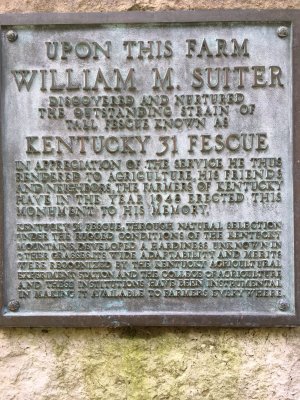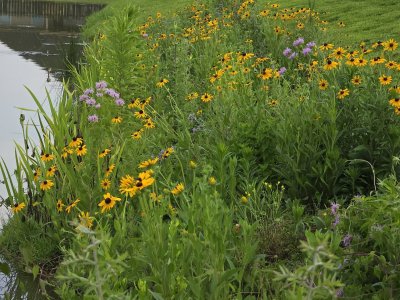I have a new pond this is being finished today and I need to plant the dam to prevent erosion. My contractor tells me to plant thick with fescue to hold the soil but I do not want to fescue on the dam if I can hold soil in a different way. I plan to sow it thick with wheat and buckwheat and add a little clover to the mix. I am not planning on this to be a food plot but what I want is for it to be covered in native forbs in the future and I think after these annuals die off and hold ground for first year then native forbs will fill in to become future plant structure. So two questions will my plan work and would you add any type seed to the mix that would help erosion in the short term? Any thoughts would be appreciated
-
If you are posting pictures, and they aren't posting in the correct orientation, please flush your browser cache and try again.
Edge
Safari/iOS
Chrome
You are using an out of date browser. It may not display this or other websites correctly.
You should upgrade or use an alternative browser.
You should upgrade or use an alternative browser.
Planting for erosion control
- Thread starter KY wild
- Start date
Brian662
5 year old buck +
Fescue may be the ticket until the new dirt work is settled and compacted a little and then you could slowly transition it to your native forbs. Forbs and natives are so slow to establish, I think your initial exposure to erosion would be unnecessary risk even with the added expense, I think I'd go that route.
Or seed with natives and place erosion mat on it, but I don't know if native forbs have enough seedling vigor to punch through an erosion mat?
Or seed with natives and place erosion mat on it, but I don't know if native forbs have enough seedling vigor to punch through an erosion mat?
Tree Spud
5 year old buck +
I would follow the contractors advice, along with Brian's. Fescue does very well in wet areas and an erosion mat is what the NRCS typically uses on damns. You need deep wide root system that can withstand wet soil. If you plant the wrong plants and erosion occurs, you will have a real problem repairing. I doubt the native forbs will work unless they can grow deep and withstand the wet soil. Switch grass would also be a good option.
I'd agree with the others and listen to the contractor since an erosion issue can wash out your entire project. As mentioned above, you can always come back and slowly plant other species a few years down the road once the dam is stabilized and has solid plant growth holding things in place.
omicron1792
5 year old buck +
Where are you located? I used Bahia instead of fescue, but agree with above you will need something more than clover and grains.
Native Hunter
5 year old buck +
The Fishman
5 year old buck +
The national park near my home had some road work done a couple of years ago where part of the work involved reworking overpasses. The contractor used erosion control mats that were seeded with native wildflowers. No idea where they purchased them, but it might be something to explore. I would suggest additional erosion control structures (e.g., straw rolls) to stop the water about halfway down if it is a large dam. If you eventually want to go native forbs, I would caution against fescue as it will be a multiyear battle to kill it.
I know, I know I agree and appreciate the advice but I am still tempted to try a different route. I know fescue and annual rye will hold the ground and keep a nice dam but it will also be poor for wildlife and will introduce the plant where it is not wanted. I would like to end up with natural forbs and bush hog once a year to keep back woody growth and this is tough once you establish a carpet of fescue. Farmers around here use wheat to prevent erosion in gullies and dips in fields with great success, it grows roots faster than fescue and germinates at a higher percentage, seems like sowed at high rate then would hold dam until next year as wild seeds join in the area. I would even like to gather milk weed seed and butterfly weed seed and put in fridge and then spread in spring into the wheat, as the wheat dies in late June the natives take hold and even after wheat is dead the roots will still be holding the ground. I feel this plan could work on a normal hillside and I would try it, problem is this is a $20,000 dollar hillside and I am afraid to try it. I am tempted to try half and half and do an experiment to see if it would work but really would rather someone else do the 20000 experiment and tell me the results. Too risky but I think thick wheat could work but also problem that it is not very good soil since dirt been mixed so much. I am located in Western Kentucky
Brian662
5 year old buck +
I've established pollinator (wild flowers) hillside sections using oats as a nurse crop.
Dump oats at selected amount into a bucket or tub. Lightly mist the oats with hose, add selected rate of flower/forb mix. Stir thoroughly. Oats will flow through a broadcast spreader and the forb seed will be stuck to the oat seed due to the moisture. Cultipack for seed to soil contact and wait. Oats are a great nurse crop as well due to very fast germination.
It's not what I would do if I was you, but it's an option.
Dump oats at selected amount into a bucket or tub. Lightly mist the oats with hose, add selected rate of flower/forb mix. Stir thoroughly. Oats will flow through a broadcast spreader and the forb seed will be stuck to the oat seed due to the moisture. Cultipack for seed to soil contact and wait. Oats are a great nurse crop as well due to very fast germination.
It's not what I would do if I was you, but it's an option.
BenA
5 year old buck +
Contact Roundstone Native Seed in Upton, KY. https://roundstoneseed.com/ I've used them on a prairie planting and a pond bank for erosion control/less maintenance. On the pond, they sent me a mix of different species that do well in both wet and dry conditions. They also threw in an annual for quick establishment. They are great to work with.
I had some bulldozer work done early this spring that washed out before the vegetation was established enough to prevent erosion. I'd recommend talking to your local NRCS and ask them what they recommend to stabilize a new dam as quickly as possible.I know, I know I agree and appreciate the advice but I am still tempted to try a different route. I know fescue and annual rye will hold the ground and keep a nice dam but it will also be poor for wildlife and will introduce the plant where it is not wanted. I would like to end up with natural forbs and bush hog once a year to keep back woody growth and this is tough once you establish a carpet of fescue. Farmers around here use wheat to prevent erosion in gullies and dips in fields with great success, it grows roots faster than fescue and germinates at a higher percentage, seems like sowed at high rate then would hold dam until next year as wild seeds join in the area. I would even like to gather milk weed seed and butterfly weed seed and put in fridge and then spread in spring into the wheat, as the wheat dies in late June the natives take hold and even after wheat is dead the roots will still be holding the ground. I feel this plan could work on a normal hillside and I would try it, problem is this is a $20,000 dollar hillside and I am afraid to try it. I am tempted to try half and half and do an experiment to see if it would work but really would rather someone else do the 20000 experiment and tell me the results. Too risky but I think thick wheat could work but also problem that it is not very good soil since dirt been mixed so much. I am located in Western Kentucky
Native forbs and flowers are great, but the risk of a washout cancels out the benefits of native forbs in my opinion. Take a bunch of before and after pictures whatever you select though as it sounds like you have an interesting project going.
bigboreblr
5 year old buck +
Pond Dam. IF it's like typical NY soils, you may have problems growing anything. How backwoods is this thing or backyardish? I would do winter rye in the mix just to get any roots for now. I'd rather have that perennial rye than the fescue. Crown vetch can do bank stabilization. Dogwood shrubs can work good too, if they grow well in your area.
I suggest some fertilizer to get things started. Is the bottom of the dam area pretty wet. Clover is one of the better things to plant that will survive ocassional flooding. Used to ressed my backyard with several thing after a usual every other year spring flood die off. Did heavy on various clovers and have no problems anymore. Dutch white ladino berseem.
The contractor bring in clay to seal things up? Also, you could have problems with muskrats, so you want to mow to be able to see rodents to combat them.
Research bank stabilization and riparian plants local to your area. Local co-op extension can be very helpful.
I suggest some fertilizer to get things started. Is the bottom of the dam area pretty wet. Clover is one of the better things to plant that will survive ocassional flooding. Used to ressed my backyard with several thing after a usual every other year spring flood die off. Did heavy on various clovers and have no problems anymore. Dutch white ladino berseem.
The contractor bring in clay to seal things up? Also, you could have problems with muskrats, so you want to mow to be able to see rodents to combat them.
Research bank stabilization and riparian plants local to your area. Local co-op extension can be very helpful.
Many good, helpful points here and I appreciate the help. I am not going to jump until the weather forecast imminent rain in the future. I am still on the fence but will spend the next few days researching more and making a decision. I am very proud of my new pond and I will love it, so I should not be so picky about the details but
TreeDaddy
5 year old buck +
gorgeous^^^^^^Here's some photos on my pond bank earlier this year. I did add in some Louisiana irises at the edge, but everything else was in the mix Roundstone sent me.
View attachment 67161View attachment 67162
bill
Similar threads
- Replies
- 17
- Views
- 661



